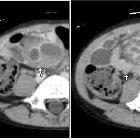ectopic pancreatic tissue

























Ectopic pancreatic tissue, also known as heterotopic pancreatic tissue, refers to the presence of pancreatic tissue in the submucosal, muscularis or subserosal layers of the luminal gastrointestinal tract outside the normal confines of the pancreas and lacking any anatomic or vascular connection with the main pancreas.
Epidemiology
It is reportedly relatively common, affecting ~5% (range 1-10%) of people.
Clinical presentation
Most commonly an asymptomatic entity.
Pathology
Location
Recognized locations for ectopic pancreatic tissue include:
- proximal duodenum
- gastric antrum including within gastric duplication cysts
- proximal jejunum
- Meckel diverticulum
- ileum
If the ectopic pancreatic tissue is functional, it is subject to the same variation of pathology that affects the normal gland, including, but not limited to pancreatitis and pancreatic tumors.
Radiographic features
On upper gastrointestinal examination, an ectopic pancreas appears as an extramucosal, smooth, broad-based lesion either along the greater curvature of the gastric antrum or in the proximal duodenum.
Barium study
In 45% of the cases of ectopic pancreas discovered on upper gastrointestinal examination, the ectopic pancreatic tissue contains a central small collection of barium, i.e. a central niche or umbilication, indicative of the rudimentary duct’s draining orifice . It is this finding that is diagnostic of ectopic pancreatic tissue.
CT
Contrast enhanced CT may show a homogeneously enhancing tissue (similar to normal pancreas) or cystic area (acinar component or pseudocyst).
Treatment and prognosis
Laparoscopic wedge resection is usually successful in removing the ectopic tissue, although its success is dependent on the location.
Siehe auch:
und weiter:

 Assoziationen und Differentialdiagnosen zu Heterotopie des Pankreas:
Assoziationen und Differentialdiagnosen zu Heterotopie des Pankreas:





